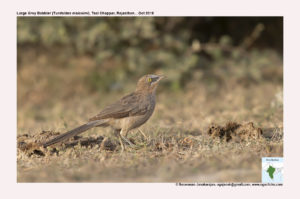
Large Grey Babbler Turdoides malcolmi
Etymology:
- Turdoides: Latin word turdus- thrush; Greek word oides –resembling { Resembling Thrush}
- Malcolmi : Ornithologist Maj.-Gen. Sir John Malcolm (1769–1833)
Vernacular Name : Hindi: Ghaughai, Satbhai, Sans: Bruhad bhasma haholika, U.P: Bhaina, Pun: Waddi serhari, Guj: Laledo, Motun lelun, Sath ben, Mar: Kokatti, Khekta, Bairagi, Rakhi Satbhai, Te: Verri-chinda, Gowa-sida, Kan: Gongya, Boodu havatemalla.
Distribution in India: Resident in North, West, Central and south India (except Kerala)
Description: Size of 27–28 cm; wt. of 63–92 g. It is a large, long-tailed, rather plain greyish Turdoides babbler with paler rump and outer tail, creamy grey below. The forecrown is pale grey with short white shaft streaks, mid-crown to nape buffy grey with scattered grey-brown flecks, mantle and back are brownish-grey with soft-edged darker grey-brown blotches, rump and uppertail-coverts are whitish-grey; upperwing is dark grey with successively paler tertials, tail is pale brownish-grey with faint narrow barring. The lores are dusky, ear-coverts are buffy grey with pale buff streaks; submoustachial area and chin to breast are pinkish grey-buff, shading to pale yellowish-buff on belly to vent. The iris is lemon-yellow; bill is horn-brown, paler base of lower mandible; legs are brownish-grey. Both the sexes are similar. The juvenile is paler overall than adult, with less grey on forecrown and no blotching on mantle.
Habitat: It is found in dry open country with sparse scrub, babul and Butea jungle, scrubland, cultivation, fallow land, open plantations and woodland, city gardens, village environs. It is found from lowlands up to 1200 m.
Food Habits: It eats insects but also feed on small lizards, molluscs and arachnids. It also eats seeds, grains and berries. It is gregarious, usually in parties of 5–12. It forages on ground and among low vegetation.
Breeding Habits: They breed throughout the year mainly in July–September in India. They are multi-brooded. Co-operative breeding recorded. The nest is built with assistance of 1–2 helpers. The nest is a loose but neat cup, made of grasses, grass roots, small twigs and roots, unlined or with slight lining of fine rootlets, fine grasses and horsehair, placed above ground in bush or small tree. They lay a clutch of 3–8 eggs. More than one female may lay in one nest; one or two helpers may assist with incubation and chick-feeding, nestlings are fed also by both parents. Brood parasitism done by Jacobin Cuckoo (Clamator jacobinus).